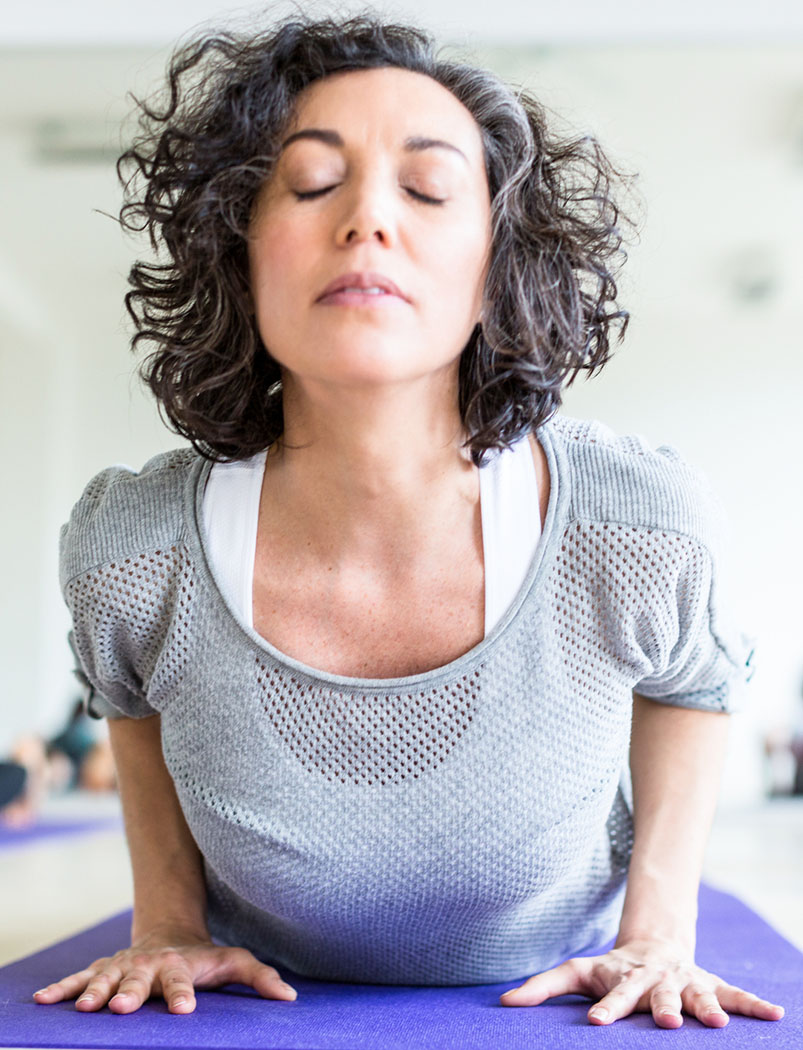
Conditions

Back and neck pain can affect your entire outlook on life. It’s difficult to be active, almost impossible to get comfortable, and even harder to engage in the everyday activities most people take for granted.
Pain in your back and neck can be the result of conditions that affect the vertebrae of your cervical spine (neck), thoracic spine (upper back), and/or lumbar spine (lower back), the discs between the vertebra, and/or the ligaments, spinal cord, and nerves around the area.
Many people believe they simply have to live with the pain or are afraid they will need major surgery in order to relieve the pain. However, over the last few years, there have been numerous advancements in technology that make alleviating back pain less invasive than ever. Dr. Radcliff uses these advanced treatment options so your pain will be alleviated, and you can start living your normal life again.
The key to finding relief from your back pain is understanding the cause of your pain. Here are some of the most common causes of back and neck pain, their symptoms, and their treatment:
Cervical Myelopathy
If you have cervical myelopathy, you have undue pressure on the spine in your neck (cervical spine) caused by a condition called cervical stenosis. This occurs due to compression of the spinal cord due to degenerative changes linked to aging. As a person ages, several things may start to happen:
- The discs between your vertebrae start drying out and being to bulge or herniate
- The shape of the vertebra changes due to arthritis, causing spur-like protrusions
- The ligaments linking your vertebrae thicken
It is a combination of these factors that usually lead to a narrowing of the spinal canal in the neck, eventually leading to pressure on the spinal cord and cervical myelopathy.
Symptoms
Because the symptoms of cervical myelopathy develop over a long period of time, may people mistakenly attribute the symptoms to “just getting older,” when, in fact, it may be treatable. These symptoms include:
- Pain, tingling, or numbness in the arms or legs
- Difficulties with coordination or speed of walking
- Difficulties with fine motor control of the hand (i.e., writing or manipulating small objects)
- A feeling of heaviness in the legs
Treatment
There are several ways to treat cervical myelopathy. Some patients in the beginning to middle stages of the condition find immobilization with a neck brace effective, while physical therapy may also be of benefit.
A small group of patients, however, may only find relief through surgery to take the pressure off the spinal cord. This is particularly true for people who display advanced symptoms that indicate nerve and spinal cord compression.
There are a number of surgical approaches for cervical myelopathy and Dr. Radcliff will discuss them with you. Surgery will probably be followed by a period of rehabilitation to ensure that you regain as much mobility as possible and to help you get back to your normal life.
Cervical Radiculopathy
Cervical radiculopathy is the clinical term that describes a nerve root in the neck area that has become inflamed or damaged that is causing pain and other symptoms in the arm/shoulder/hand area. It most commonly results from degenerative changes to the cervical spine (such as bone spurs and cervical disc herniations) over long periods of time but can also occur due to acute injury or illness.
Symptoms
With cervical radiculopathy, pain can radiate from the neck to anywhere along the arm area, including the shoulder, hand, and fingers. Other symptoms in this area can include:
- Numbness
- Altered reflexes
- Weakness
- Tingling
Treatment
Cervical radiculopathy can be treated in a number of different ways, both surgically and non-surgically. Non-surgical treatments are typically the first line of treatment and can include:
- Rest or activity modification
- Physical therapy
- Ice and/or heat therapy
- Medication including over-the-counter anti-inflammatory drugs and/or pain relievers
- Cervical traction
- Manual manipulation
- Epidural steroid injection
If non-surgical treatments don’t provide the pain relief you are looking for, surgery could be the next step. Dr. Radcliff performs several minimally invasive procedures for cervical radiculopathy and will discuss the different options with you.
Cervical Stenosis
When the degeneration of the spine leads to a narrowing of the spinal canal, spinal stenosis occurs. Cervical spinal stenosis is usually a slow process that occurs over years and is related to arthritis. It results in thickening of the ligaments, formation of bone spurs, and deterioration of the disc material. As a result, the spinal canal narrows and pinches the nerves. Bone spurs may also press on the spinal cord.
Symptoms
Cervical stenosis may cause the following symptoms:
- Neck or arm pain
- Numbness and weakness in both hands
- Loss of coordination when walking or during other activities
- Muscle spasms in the legs
Cervical stenosis may require surgery, possibly urgent or even emergency surgery.
Treatment
Conservative treatment may be sufficient to alleviate symptoms of stenosis. Surgery may be recommended if there are signs that the spinal cord is compressed or there is a significant risk that the spinal cord may become damaged. Surgery is necessary if neurological symptoms increase (i.e., a patient has difficulty with balance or walking). In cervical stenosis, discs and spurs can be removed from the front or back of the neck. Spinal fusion may be performed to stabilize the spine or if a disc is removed.
Compression Fractures
Compression fractures occur when one or more bones in the spine weaken and crumple, which can lead to pain, deformity, and loss of height. These fractures more commonly occur in the thoracic spine (the middle portion of the spine), especially in the lower part.
The condition is typically caused by a loss of bone mass (osteoporosis) that occurs as part of aging. In people with severe osteoporosis (weak, brittle bones), a compression fracture may be caused by simple daily activities, such as stepping out of the shower, sneezing forcefully, or lifting a light object. In people with moderate osteoporosis, it usually takes increased force or trauma, such as falling or attempting to lift a heavy object to cause a compression fracture.
Symptoms
Compression fracture symptoms range from mild to severe, and include:
- Back pain – This can develop anywhere between the shoulders and lower back. The pain usually gets better when you lie down, and it worsens when you stand or walk.
- Decreased mobility or flexibility in the spine – You may not be able to twist or bend over.
- Hunched over appearance
- Loss of height – Occurs as the vertebrae compress and the back curves.
- Pinched nerves – Can cause tingling and numbness in the back and difficulty walking.
- Bladder or bowel control problems
Treatment
Treatment for compression fractures focuses on relieving pain, stabilizing the bones in the spine, and preventing another fracture. Depending on the severity of the fracture and your overall health, treatment may include:
- Medication for relieving pain – Sometimes over-the-counter, non-steroidal anti-inflammatory drugs (NSAIDs) may be enough to relieve pain, or Dr. Radcliff may feel like a prescription pain reliever may work better for you
- Medications to strengthen bones – Drugs called bisphosphonates can slow further bone loss, stabilize the bones and prevent fractures.
- Bracing – A special type of back brace can support your vertebrae and relieve pain by reducing how much you move your spine.
- Physical therapy – This concentrates on strengthening the muscles and ligaments that support and stabilize the spine, as well as improving balance and mobility.
In rare cases when symptoms are disabling, surgery may be needed. If this is the case, Dr. Radcliff will typically perform a minimally invasive procedure called kyphoplasty. During the procedure, Dr. Radcliff inserts a balloon-like device. As the device is inflated, it opens up a space that is then filled with bone cement.
Degenerative Disc Disease
Degenerative disc disease is a common condition among aging adults. The condition describes the process of degenerative changes that occur in the discs – the soft, gel-like pads located between the vertebrae of your spine. Wear and tear on your spine over time cause the discs to gradually lose their ability to cushion the vertebrae.
At the same time, the outer layer of the spine can develop cracks, which gradually worsen. The discs may also develop herniated areas, which is where the central portion of the disc protrudes through the outer layer.
Symptoms
A disc herniation in the spine may result in:
- Shooting pain in the arms or legs
- Localized severe pain or burning in the back or neck
- Weakness in the arms or legs
- Changes in bowel or bladder activity
- Changes in bowel or bladder activity
- Lack of sensation or pins and needles tingling in arms or legs
Despite the fact that the physical degeneration in your spine will gradually progress over time, the good news is that your symptoms may not necessarily progress to the same extent. Sometimes, symptoms can even improve over time.
For some people, however, particularly if the pain levels are severe, or if there is pressure on the nerve roots, symptoms will continue to escalate with time.
Treatment
Most people with degenerative disc disease respond well to conservative, non-surgical treatment. This conservative treatment typically includes anti-inflammatory medication and pain relievers. Physical therapy can help manage your symptoms and may include manual therapy, heat, and other pain-relieving methods, stretching, strengthening exercises, and education to help you manage your condition.
For a small group of people who don’t respond to conservative treatment, surgery may be necessary, particularly if there are signs and symptoms of nerve compression or joint instability. There is a wide range of surgical techniques that can be used to help degenerative disc disease, depending on the extent and nature of the damage to the disc and spine. Dr. Radcliff will discuss with you fully the type of surgery he recommends for your individual circumstances and will work with you to develop a treatment plan.
Herniated Discs
The term “herniated disc” refers to a problem with one of the rubbery, gel-like cushions between the vertebrae of the spine. Disc herniation occurs when the interior “jelly” of the disc pushes through the tougher exterior and irritates nearby nerves, which results in pain that ranges from mild to severe.
When a disc is herniated, it may bulge and the jelly-like interior could leak out through a tear, or the bulge may press against or pinch a nerve.
Symptoms
Where the symptoms appear depends on what part of your spine the herniated disc is located. In general, symptoms include:
- Pain in your arms, shoulders, legs, buttocks, thighs, or calves
- Numbness or tingling in your arms or legs
- Weakness in your arms, hands, or legs
Pain is caused by inflammatory chemicals that are released around the injured area, and the injured disc can also put pressure on the nerve roots as they travel through the adjoining tunnel to and from the spinal cord. This can cause pain, pins and needles, and numbness in your extremities and can lead to significant muscular weakness.
Treatment
Most people with mild disc herniation will improve on their own in about six to eight weeks. For others, however, the pain will be more intense and persistent, and physical therapy may be indicated to help alleviate symptoms. Anti-inflammatory medication and pain relievers may also be necessary.
In a small group of people, symptoms don’t respond to conservative measures or time. When this is the case, Dr. Radcliff may recommend surgery, particularly if there is persistent pain or weakness in your arms or legs. When surgery is indicated, it is usually performed to reduce the pressure from the herniated disc on surrounding tissue and nerve roots.
Dr. Radcliff performs several different types of minimally invasive surgical procedures for herniated discs and will discuss these procedures with you.
Sciatica
Sciatica is a general term used to explain pain caused by sciatic nerve irritation. As the longest and widest nerve in the human body, the sciatic nerve runs from the lower back, through the buttocks, down the legs, and ends just after the knee.
This quintessential nerve controls multiple nerves in the lower legs and is responsible for sensation in the area. While there are a number of things that can irritate this nerve, the most common cause of the irritation is a compressed nerve root in the lower spine.
Symptoms
The main symptom of sciatica is pain that radiates from your lower (lumbar) spine to your buttock and down the back of your leg. This pain can vary widely, from a mild ache to a sharp, burning sensation or excruciating pain. Typically, only one side of your body is affected.
Some people may also experience numbness, tingling, or muscle weakness in the affected leg or foot. You might have pain in one part of your leg and numbness in another part.
Treatment
The methods of treatment for sciatica will greatly depend on the affected area of the patient’s body as well as the classification of sciatica. There are two different classifications of sciatica:
- Acute or short-term sciatica
- Chronic or long-term sciatica
Acute sciatica can last anywhere from four to six weeks, while chronic sciatica can persist significantly longer. Acute sciatica may be remedied with the use of hot and cold packs, over-the-counter painkillers, and exercises.
In contrast, chronic sciatica commonly requires more intensive medical treatments, such as physical therapy, exercise, and applied heat. Patients with either acute or chronic sciatica may require surgery to be relieved of the symptoms.
SI Joint Disorders
The SI (sacroiliac) joint is located in the pelvis and links the iliac bones (pelvis) to the sacrum (the lowest part of the spine, right above the tailbone). It is an essential component for shock absorption to prevent impact forces from reaching the spine.
Like any other joint in the body, the SI joint can be injured or become degenerative. When this happens, people can feel pain in their buttocks and sometimes in the lower back and legs. This is especially true while lifting, running, walking, or even sleeping on the involved side. Degenerative joint issues, traumatic injury, or inflammatory joint disease are the leading causes of SI joint disorders.
Symptoms
These can include:
- Lower back pain
- Sensation of low extremity pain, numbness, tingling, weakness
- Pelvis/buttock pain
- Hip/groin pain
- Feeling of leg instability (buckling, giving way)
- Disturbed sleep patterns due to pain
- Disturbed sitting patterns (unable to sit for long periods, sitting on one side)
- Pain going from sitting to standing
Treatment
Initial non-surgical treatments for SI joint pain typically include:
- Brief rest period of 1 – 2 days
- Applying ice or heat to reduce inflammation and alleviate pain and discomfort
- Pain medication
- Manual manipulation of the SI joint by a qualified health professional
- Supports or braces
- Sacroiliac joint injections
- Stretching
- Strengthening exercises
If non-surgical treatments are ineffective, Dr. Radcliff may recommend minimally invasive SI joint fusion.
Spinal Stenosis
Spinal stenosis of the back is usually a slow process that occurs over years and results in thickening of the ligaments, formation of bone spurs, and deterioration of the disc material. As a result, the spinal canal narrows and pinches the nerves. Bone spurs may also press on the spinal cord.
Lumbar Stenosis – May produce lower back pain and leg discomfort or pain. Surgery may be necessary if lumbar stenosis limits normal activity, causes leg weakness and/or numbness, makes standing or walking difficult, or affects your ability to control bowel and bladder functions.
Thoracic Stenosis – The thoracic spine in the upper back has some unique characteristics that make thoracic spinal stenosis a little different than stenosis in other areas. Because the 12 thoracic vertebrae connect to the 12 sets of ribs that protect major organs, the thoracic spine is more fixed than the cervical (neck) or lumbar (lower back) areas. The spinal canal is narrower than the rest of the spine, too.
Symptoms
Symptoms may include:
- Back pain
- Radiating pain into the legs, especially when moving
- Leg weakness and/or numbness
- Difficulty standing or walking
- Change in bowel or bladder function
Treatment
Often, conservative treatment of physical therapy, anti-inflammatory medication, and/or pain relievers may be sufficient to alleviate symptoms of stenosis.
However, Dr. Radcliff will typically recommend surgery if there are signs that the spinal cord or nerves are compressed. Surgery is necessary if neurological symptoms increase, such as difficulty with balance or walking.
If Dr. Radcliff feels surgery is your best option, he will recommend the least invasive approach that will give you the most optimum outcome.


